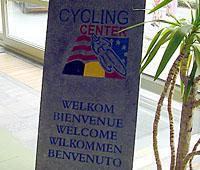
Recently on Cyclingnews.com |
Tales from the peloton, November 21, 2004
The Cycling Center gets bigger
Developing more young U.S. riders in Belgium
The Cycling Center is a privately run program based in Belgium primarily aimed at young American riders looking to improve their cycling. It is run by Bernard Moerman, a retired pro football player, and his wife Ann Dusauchoit. In the 14 years of its existence, it has grown into a major operation - on a par with a division II team in terms of staff and rider numbers - but with a different approach to racing. Cyclingnews' Chief Online Editor Jeff Jones went out to Hertsberge to discuss the latest developments in the 14 year-old project with CC boss Bernard Moerman.
The Cycling Center
Staff Manager: Bernard Moerman 2004 ABC-Aitos ridersTyson Apostol, Jonas Boli, Jared Bunde, Mike Busa, Daniel Corum, Ben Duke, Jaime Gandara, Justin Hale, Evan Hepner, Trevor Irons, Chris Irvin, Ron Jensen, Eric Keim, Austin King, Isaiah Knouff, Lere Lambrecht, Gabriel Larrea, Matt Pacocha, Jon Parrish, Ryan Phelps, Jake Rytlewski, Bryan Smith, Corey Steinbrecher, Hans Taufen, Bartolo Torre, Bennet van der Geneugten, Mike Voigt, Scott Walters. Team website: www.cyclingcenter.com |
Cyclingnews last visited the Cycling Center in 2002, when it was housed in the Belgian coastal town of Oostende. But in under two years, there have been a lot of changes, mainly of the growth variety. Bernard bought a much larger place (an old hotel with restaurant) in Hertsberge, about eight kilometres away from Brugge and not that far removed from the old location in Oostende. Not coincidentally, it is also only 30 km away from the US U23 national team house in Izegem. Over the years, the two programs have developed a close relationship with each other and Bernard's riders are often "borrowed" by US U23 coach Noel Dejonckheere to race with the national team, which naturally benefits both parties, knowing that this year, 34 riders came through the Cycling Center programs.
Bernard and Ann aim to provide a home away from home for all the riders who sign up for their program. Their motto: "When the head is not clear nothing works, therefore riders should feel at home so that they can relax after a hard day of training or racing." Thus, there has been considerable effort spent renovating the new Cycling Center in order to comfortably house approximately 25 riders throughout the season. Not an easy task, especially given the day to day demands of being the manager of the whole enterprise.
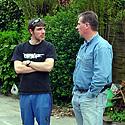
|
"It looks like I invented a new wheel," Bernard tells me during my second visit earlier this year. "But we just did what we said we would do. We're not promising heaven, but we can provide a decent platform, giving the riders Dutch lessons, nutrition lessons, and even visits from [Lance Armstrong's soigneur] Freddy Viaene."
Most of the riders are young guys from the USA, ranging from 18-25 years old, who simply want to find out how far they can get with cycling and whether they have what it takes to be a pro. "If you look at the Tour of Georgia in the US this year, you'll see that there weren't that many young riders. It's not a race for that sort of development. If you are serious, you need to go step by step and start by coming over here. The Belgian kermises are easy to access, and you can find your way more gradually here than in the US. With us, you can do a decent program with several big races during the season.
"Talent can only be developed by racing at the top. For the first two months, it's one surprise to another. Some riders just want to come for six weeks, but that's almost a waste of time because you'll probably only race for three weeks. It can take 10 days to get over jetlag and get used to the racing, and another 10 days when you get sick."
"Why should I invest in a rider who isn't prepared to invest in themselves?"- Bernard Moerman justifies his 'rider pays' funding plan |
To select his riders, Bernard goes through a three-level process. The first is a questionnaire consisting of general questions, to ascertain the character of the applicant. The second is a questionnaire about the applicant's past season, concerning their training habits, sporting approach and coachability. Finally, the rider is referenced via three people who know him as a person and as a competitor.
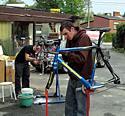
|
"Past results mostly don't matter," Bernard explains matter-of-factly. "What's more important is 'Is he open to learning? Can he live with other people?' I find the guys that do best here are the middle guys, those who can take uppercuts and hang in there. The top guys can go to the bottom too easily when they find they're at a harder level here."
It's still very popular. "We have enough applications to fill up the next two years, but we want to be open to as much ambitious talent as possible," Bernard adds. "I had 212 guys applying!" The program is not exclusive to US riders, but Bernard has found that it's the easiest way to make things click. This year he took on two Swedes and one Finn, specifying that "all need to live by the rules" and fit in with the US bent of the team.
Funding the programs
One of Bernard's oft quoted mottos is, "Why should I invest in a rider who isn't prepared to invest in themselves?" The Cycling Center is a pay-your-own-way deal, with a full six month season costing €4500 for the Development program, and a reduced rate for the more advanced Excellence program. The funding for the latter is determined by the Cycling Center foundation, which awards grants to the riders. A rider can only reach the Excellence program after going through the Development program.
"The entire race program is designed to let the excellence riders blossom," explains Bernard. "They are first choice to do the UCI ranked pro-am races in Europe and the USA. Those guys, when fit, do a lot of races like Univest, Tour of Flanders for amateurs, Boucles de l'Artois, Flèche du Sud, Olympia's Tour and so on."

|
The "rider pays" system is still barely enough to properly fund a cycling team, and to that end, Bernard and the Cycling Center have been quite active in attracting sponsorship. The riders' bikes, stems, saddles, tyres, wheels, tools, sunglasses, food and heart rate monitors are all covered, which takes care of most of their material needs. Financial sponsors have been more difficult to find, but Bernard says that he now has four sponsors contributing approximately 20 percent of the budget. This year, ING Bank, Bional, Xango and Safeco came on board, and negotiations are in progress to attract more. "Since we race on both sides of the ocean, those things take longer since more parties are involved."
Another 20 percent of the budget has come from donations to the Cycling Center foundation. "All this might not look as sexy compared to what some teams can show all of a sudden, but hardly any of those teams are there for the tenth year and at the start of our fifteenth season in development like we are."
Bernard sums it up as follows: "With this budget I can have my program as it is now. With more sponsorship I can do more. Since our program is unique, we get invitations from all over: we are now racing in Belgium, Holland, Luxembourg, Germany, France, Austria, Spain and the USA. For next year, we also have invitations to race in Japan, China, Mexico, Portugal and Norway. Therefore we need more financial sponsors."

|
In return for sponsorship, the Cycling Center offers exposure. The usual logos on the jerseys, team cars and website (www.cyclingcenter.com) are supplemented by exposure in the media. For example, the Cycling Center featured on the Belgian prime-time TV show Man Bijt Hond this year, totaling 30 minutes of TV time. With cycling such a big sport in Belgium, these sort of "sporting lifestyle" programs are popular. Ever seen De Planckaerts?
In addition to sponsorship, Bernard is looking at other ways to earn money for the Cycling Center. One method is charging VIPs to come and watch the races. "On Sunday we had eight VIPs at a sort of 'Day at the Races'. They have breakfast, go to the race, hang out in the VIP tent, see the riders preparing, follow the race and eat dinner with us."
Bernard has also started a potentially lucrative Masters program to help kick the Cycling Center along. "Masters racers have three things: heart, time and money," says Bernard. "They form a strong part of the future business plan of the Cycling Center as we will put 30 percent of the proceeds towards our development team. We are trying to work it so that the Excellence program is free for third years, who have a decent chance of making it. But first they have to invest in themselves..."
"I want us to be the Harvard of Cycling in 2008...If it's in you, here's a place to grow."- Bernard Moerman's ambitions are clear and well-formed |
One of those Masters programs is basically a cycling holiday to the spring classics, with the option of racing in Belgium if the rider desires. The 10 day itinerary includes visits to the Tour of Flanders, Gent-Wevelgem and Paris-Roubaix with training rides and sightseeing in between. At up to $US3200 per person, it's not exactly cheap, but for a rabid classics fan it could be the ideal holiday.
From the Cycling Center to the pro ranks

|
One of the aims of the Cycling Center is to develop riders into professionals - teaching them all there is to know about cycling, short of actually riding the bike for them. Naturally, results are important for a young rider who wants to turn pro, but when he gets there, he needs to know how to look after himself and devote all his energy to riding.
"I want us to be the Harvard of Cycling in 2008," Bernard states emphatically. "It takes two to three years to develop. If it's in you, here's a place to grow." He is quick to point out that, "A rider like Lance Armstrong doesn't need this. Those top riders will get there anyway."
Among the other things that a professional cyclist has to be concerned with is the wrangling that goes on behind their contracts. "Being a pro is a stressful life," he says. "For example, there is the pressure of negotiating a contract. That takes it out of a cyclist."
But Bernard believes that way too many new riders make the mistake of going for the money first. "First you talk about development and get yourself to a level as high as possible," he says. "Only when you can start talking about making over US$40,000 per year, then you can talk about money. For me, being a pro means it needs to be visible on your bank account, not only on your license. As long this is not there, you're no pro. Lots of good young riders would be much better off going for the development for one or two more years and then go for the 'real deal'."
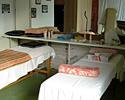
|
Due to the large number of potential pro's but only a limited number of spots in pro teams, getting a contract is not easy. Matters have been complicated by the current doping climate, which means that teams are becoming (slightly) more wary of hiring new riders unless they have a good knowledge of their history. Bernard has a zero-tolerance policy with respect to drugs, but he is going beyond that to ensure that his riders are clean all the way through.
"Taking a new guy is a risk," he says. "Is he clean? If I have a guy, I want to be able to guarantee that. So we file all their [medical] tests and have a complete book of them after three years of following this guy. If a pro team is interested, then we can show them all the tests."
Thus, at the very least, the Cycling Center wants to produce riders that are clean, coachable and understand a lot of the nuances of being a full time athlete.
Probably the best Cycling Center "product" so far is Jeff Louder, who will start his sixth season as a pro next year. Louder rode with the Cycling Center up until 2000, when he turned pro with Tönissteiner. He continued in 2001-2002 with Landbouwkrediet-Colnago before signing with U.S. division II team Navigators in 2003, where he is now. This year, Louder recorded his first pro victory in Stage 2 of the Tour of Qinghai Lake in China, as well as winning the mountains competition in the GP de Beauce.
The Center has also produced several other riders who have gone on to ride professionally, such as Iniaky Barrenechea, Nicolas Coudray, Niklas Ekström, Jonas Jacobson, Kristoffer Johanson (all Landbouwkrediet-Colnago), Brian Sheedy (Navigators), Benjamin Sharp and Jacob Fetty (West Virginia-Go Mart), Austin King (Jelly Belly), Jed Schneider (Jittery Joe's), Fredrik Johansson (Barloworld) and Jussi Veikkanen (FdJeux).
Bigger, better, more
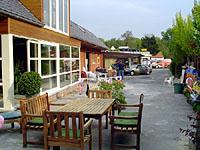
|
By the looks of it, the Cycling Center is on a slow but sure path in continuing to help the development of young, mainly American riders. Bernard Moerman's approach to his squad is radically different to most Belgian team managers, who tend to value results above everything else. But it's a sound approach that is gradually bearing fruit, and the Cycling Center should be around for many years to come.
Photography
Images by Jeff Jones/Cyclingnews.com
- The Cycling Center is a large, rambling hotel/restaurant building in Hertsberge, in the west of Belgium
- Sponsor logos are in full view of everyone at the Cycling Center
- Welcome to the Cycling Center in Hertsberge
- The US flag reflects the strong American tone of the Cycling Center
- Jerseys and posters of cycling stars adorn the hallway
- Formerly a hotel with restaurant, the new Cycling Center makes good use of its furnishings
- The lounge room of the Cycling Center is large and well furnished. There's even wireless Internet.
- The bar has its uses! Is that Hoegaarden on tap?
- Bernard's office isn't quite finished yet
- Some parts of the Center are still being renovated, but things are coming along quickly
- The massage room of the Cycling Center is well equipped
- The massage room has plenty of inspirational photos
- The shed containing all the team bikes
- Bernard Moerman (R) chats to one of his riders
- Making sure that everything is spic and span
- The Litespeed Avior bikes have to be cleaned often
- Tote that barge, wash those bikes
- Riders clothes have to be washed daily too

